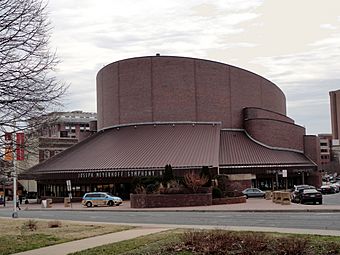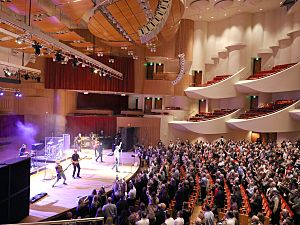Joseph Meyerhoff Symphony Hall facts for kids
 |
|
| Address | 1212 Cathedral Street Baltimore, Maryland United States |
|---|---|
| Public transit | Cultural Center State Center |
| Owner | Baltimore Symphony Orchestra |
| Type | Concert hall |
| Capacity | 2,443 |
| Construction | |
| Broke ground | November 10, 1978 |
| Opened | September 13, 1982 |
| Years active | 1982 - present |
| Architect | Pietro Belluschi, Inc. and Jung/Brannen Associates |
The Joseph Meyerhoff Symphony Hall, often called the Meyerhoff, is a special place for music in Baltimore, Maryland. It opened on September 16, 1982. This building is located at 1212 Cathedral Street. The main hall can seat 2,443 people. It is the home of the famous Baltimore Symphony Orchestra. The hall is named after Joseph Meyerhoff. He was a businessman and a kind person who loved the arts. He helped the Baltimore Symphony for many years.
Contents
Exploring the Meyerhoff's Design
The Meyerhoff Symphony Hall has a modern look. It was designed by two architecture companies. These were Pietro Belluschi, Inc. and Jung/Brannen Associates. Construction started on November 10, 1978.
Sound and Shape: How the Hall Works
The hall's sound design is very special. It was created by Bolt, Beranek and Newman. They used curved shapes everywhere inside. This helps the sound travel perfectly. It stops echoes and makes the music sound amazing.
The main concert room is shaped like an oval. Its walls go all the way up to the roof. The roof slopes down over the stage. Outside, the oval part is covered in brown brick. You can see it rising through the lobby.
Outside and Inside Features
The lobby and visitor areas are under a sloped metal roof. The front of the building has big glass walls. These walls open up the building to the plaza outside. This makes the building feel welcoming.
The ceiling inside the hall is high. It is about 44 feet (13 meters) above the stage. At the back wall, it reaches 62 feet (19 meters). The stage walls are made of light-colored wood. They also have special box seats.
Improving the Sound Over Time
When the hall first opened, it had 52 concrete "clouds" above the stage. These helped spread the sound. In 1990, more sound tools were added. These were meant to help the musicians hear better.
However, these new tools were not perfect. They were removed after a few years. In 2001, the hall had a big makeover. New sound tools were put in. This project also added new stage lights. It made the stage bigger and improved dressing rooms. There were also more restrooms and better access for people with disabilities.
The Stage and Other Rooms
The stage is 65 feet (20 meters) wide. It is also 35 feet (11 meters) deep. If a choir needs to perform, the back wall can move. This adds 12 feet (3.7 meters) of space.
Besides the main hall, there are other rooms. These include the John Gidwitz Recital Hall. There are also rooms for meetings and offices.
Getting There: Public Transport
The Meyerhoff is easy to reach by public transport. It is right next to the Cultural Center Station. This is on the Baltimore Light Rail. It is also a short walk from the State Center Station. That station is on the Baltimore Metro Subway.
A Look Back: The Hall's History
The idea for a new home for the Baltimore Symphony Orchestra started in 1969. The conductor, Sergiu Comissiona, and director, Joseph Leavitt, had the idea. At that time, the orchestra played at the Lyric Opera House.
Why a New Home Was Needed
The orchestra often had problems with scheduling. They had to practice in school gyms. They also got ready for concerts in small, dark backstage areas. A new building would give them a proper home.
Joseph Meyerhoff gave a lot of money for the new hall. The State of Maryland and the City of Baltimore also gave grants. This funding made the new hall possible.
Opening Night Performance
The Meyerhoff Symphony Hall opened with a special concert. Conductor Sergiu Comissiona led the orchestra. They played a brand new piece of music. It was called Housewarming by Morton Gould. This piece was written just for the opening. Other music played that night included Symphonic Variations by César Franck. The famous pianist Leon Fleisher performed in it. They also played Ein Heldenleben by Richard Strauss.



